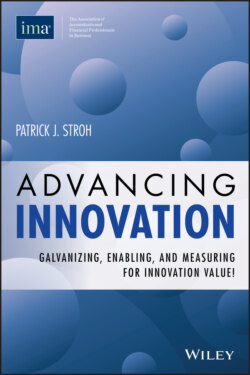Читать книгу Advancing Innovation - Patrick J. Stroh - Страница 29
На сайте Литреса книга снята с продажи.
CHARACTERISTICS AND ROLES OF THE INNOVATION LEADER
ОглавлениеSo what exactly should an innovation leader embody? What would I look for in the person I want to lead and drive innovation at my company? The following is a representation of the characteristics and traits that innovation leaders should have and aspire to have:
Strategic Agility—be strategically aware and able to execute tactically in the short term, but also have an eye on long-term strategic planning. I like to call this “Short-term Focus, Long-term View.” Facilitation Skills— believe in the benefits of innovation, but not necessarily be the creative, innovative thinker. In most cases, the innovation leader actually should not be the creative thinker or, at least, should not be the only creative thinker.
Organizational Agility—create an environment that values, allows, and enables innovators to operate and succeed. To facilitate this, be organizationally savvy and understand influence and power relationships within and across functional areas.
Organizational Influence—be a “powerful” executive who can counterbalance the natural biases of business units and functional areas when it comes to change and new innovation ideas.
Consultative —be consultative to innovators and leaders by asking questions that continue to peel back the onion to the layers of value, by setting up innovators for success by recalling historical efforts (wins and losses), and by providing insights on functional relationships and interdependencies, turbulence, or other factors the innovators may not be considering.
Inside/Outside Views—have a watchful eye on internal developments, initiatives, and improvements while keeping an external eye on customer loyalty, retention, satisfaction, and needs. Always be considering new projects, new markets, new partnerships, and alliances to look at value creation and expediency.
Excellent Communication Skills—be able to communicate in many forms and with many constituents both inside and outside the company. That does not mean you need to be a “Master of Creativity or Ideas.” The role of innovation leader includes the above elements as well as being able to communicate effectively. How many people do you know are good at relating to the challenges of front-line employees and can also talk to a Wall Street analyst, a CEO, a key supplier, and so on? It’s a master communicator!
In a McKinsey study, innovation leaders were asked what they do well.12 Across the eight factors, “aspire,” “discover,” and “mobilize” came to the top. Areas that ranked lowest included “choose” and “evolve.” Each of us makes choices and evolves every day in our companies’ various processes (see the interdependencies discussion in Chapter 11). So why do we struggle in these areas in regards to innovation—to choose and evolve? If you apply innovation governance in your company in the way I discuss it in this book, you could improve in these areas.
Others in the field have made similar lists of what an innovation leader should do, such as:
Be adept at using innovation tools.
Create frequent opportunities for blue-sky thinking.
Avoid premature judgments when evaluating new options.
Demonstrate an appetite for unconventional ideas.
Recognize innovators and celebrate “smart failures.”
Personally mentor innovation teams.
Free up time and money for innovation.
Hire and promote for creativity.
Work to eliminate bureaucratic impediments to innovation.
Understand and apply the principles of rapid prototyping and low-cost experimentation.13
The important point is that nowhere on this list or any other list of suggested traits for an innovation leader does it say that he or she should be “the sole ideas person.” It is simply a myth and misconception that the innovation leader should be the source of all, or even a majority of, ideation and innovation in a business. What is in all of these descriptions are traits like managing, nurturing, balancing, listening, assessing, providing, etc. These are traits around the leadership and governance of innovation!
